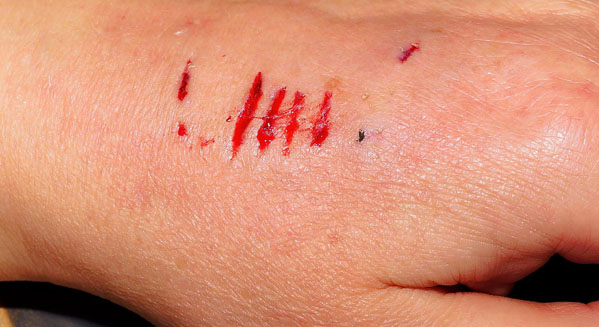Advice from a Certified Hand Therapist: Why Bite Injuries to the Hand and Arm Are Serious
According to Rehabilitation of the Hand and Upper Extremity, dog bites are known as the most common type of animal bite in the United States, accounting for 60-90% of all bite wounds. Cat bites only make up 10-15% of animal bites, but they account for a higher number of infections overall. The difference in infection rate occurs because of the difference in mechanism of bites between cats and dogs. Cats’ teeth are sharp and fine and are meant to penetrate the skin. Dog bites move in a crush and tear pattern. Because of this, 50% of cat bites lead to infection; whereas infection due to dog bites is less common.
The hand and fingers are the most common areas bitten, and they are most at risk for complications. Bites that happen near or at the joint spaces (between the bones) are at risk for infection because the fluid that naturally occurs in the joint creates an optimal environment for infectious bacteria to flourish. Bites that puncture the finger can extend into the tunnels where tendons travel. These areas are also ideal for bacterial growth and are therefore equally prone to infection.
Infections in the hand and fingers can cause significant functional impairments and disability, so timely treatment is important. First, it is important to properly cleanse a wound with soap and water as soon as possible after the bite occurs. Additionally, it is imperative to monitor the area for any signs of infection so medical attention can be provided as soon as possible if necessary. Identifying the signs and symptoms of infection is key.
● Redness, especially when it extends beyond the original boundaries of the wound or affected area
● Warmth or increased heat in the affected area and in the surrounding tissues
● Swelling
● Pain (this will often worsen as infection sets in)
● Loss of motion or stiffness with motion
If the above signs are present, it is important to seek medical attention as soon as possible. Antibiotics are often provided to help stop or slow infection. Additionally, referral to a hand doctor is sometimes necessary to help cleanse the wound and get rid of the infection. This is called “debridement” and may be a small procedure that can be done in a doctor’s office. For more involved bite wounds or advanced infections, surgical intervention may be necessary.
Following treatment, the wound area may be bandaged and/or immobilized to allow for healing. As the wound heals, your physician may refer you to hand therapy to address any joint stiffness, pain, and/or loss of function that may occur.
The hand and fingers are the most common areas bitten, and they are most at risk for complications. Bites that happen near or at the joint spaces (between the bones) are at risk for infection because the fluid that naturally occurs in the joint creates an optimal environment for infectious bacteria to flourish. Bites that puncture the finger can extend into the tunnels where tendons travel. These areas are also ideal for bacterial growth and are therefore equally prone to infection.
Infections in the hand and fingers can cause significant functional impairments and disability, so timely treatment is important. First, it is important to properly cleanse a wound with soap and water as soon as possible after the bite occurs. Additionally, it is imperative to monitor the area for any signs of infection so medical attention can be provided as soon as possible if necessary. Identifying the signs and symptoms of infection is key.

Signs and Symptoms of Infection:
● Redness, especially when it extends beyond the original boundaries of the wound or affected area● Warmth or increased heat in the affected area and in the surrounding tissues
● Swelling
● Pain (this will often worsen as infection sets in)
● Loss of motion or stiffness with motion
If the above signs are present, it is important to seek medical attention as soon as possible. Antibiotics are often provided to help stop or slow infection. Additionally, referral to a hand doctor is sometimes necessary to help cleanse the wound and get rid of the infection. This is called “debridement” and may be a small procedure that can be done in a doctor’s office. For more involved bite wounds or advanced infections, surgical intervention may be necessary.
Following treatment, the wound area may be bandaged and/or immobilized to allow for healing. As the wound heals, your physician may refer you to hand therapy to address any joint stiffness, pain, and/or loss of function that may occur.
Steph Clement Pogonowski, MS, OTR/L, CHT is a Certified Hand Therapist and a member of the American Society of Hand Therapists (ASHT).
Find a hand surgeon near you
Using this search tool means you agree to the user agreement and disclaimer.